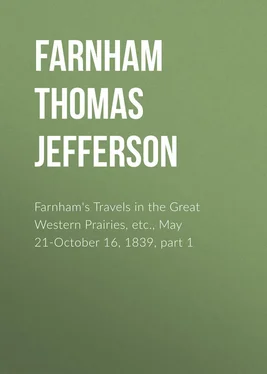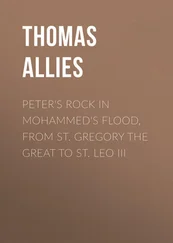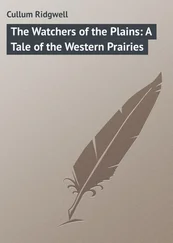Thomas Farnham - Farnham's Travels in the Great Western Prairies, etc., May 21-October 16, 1839, part 1
Здесь есть возможность читать онлайн «Thomas Farnham - Farnham's Travels in the Great Western Prairies, etc., May 21-October 16, 1839, part 1» — ознакомительный отрывок электронной книги совершенно бесплатно, а после прочтения отрывка купить полную версию. В некоторых случаях можно слушать аудио, скачать через торрент в формате fb2 и присутствует краткое содержание. Издательство: Иностранный паблик, Жанр: foreign_antique, foreign_prose, Путешествия и география, на английском языке. Описание произведения, (предисловие) а так же отзывы посетителей доступны на портале библиотеки ЛибКат.
- Название:Farnham's Travels in the Great Western Prairies, etc., May 21-October 16, 1839, part 1
- Автор:
- Издательство:Иностранный паблик
- Жанр:
- Год:неизвестен
- ISBN:нет данных
- Рейтинг книги:3 / 5. Голосов: 1
-
Избранное:Добавить в избранное
- Отзывы:
-
Ваша оценка:
- 60
- 1
- 2
- 3
- 4
- 5
Farnham's Travels in the Great Western Prairies, etc., May 21-October 16, 1839, part 1: краткое содержание, описание и аннотация
Предлагаем к чтению аннотацию, описание, краткое содержание или предисловие (зависит от того, что написал сам автор книги «Farnham's Travels in the Great Western Prairies, etc., May 21-October 16, 1839, part 1»). Если вы не нашли необходимую информацию о книге — напишите в комментариях, мы постараемся отыскать её.
Farnham's Travels in the Great Western Prairies, etc., May 21-October 16, 1839, part 1 — читать онлайн ознакомительный отрывок
Ниже представлен текст книги, разбитый по страницам. Система сохранения места последней прочитанной страницы, позволяет с удобством читать онлайн бесплатно книгу «Farnham's Travels in the Great Western Prairies, etc., May 21-October 16, 1839, part 1», без необходимости каждый раз заново искать на чём Вы остановились. Поставьте закладку, и сможете в любой момент перейти на страницу, на которой закончили чтение.
Интервал:
Закладка:
The Trinity River, the Brazos, and the Rio Colorado, have each a course of about twelve hundred miles, rising in the plains and mountains on the north and north-west side of Texas, and running south south-east into the Gulf of Mexico.
The Rio Bravo del Norte 60 60 For this river see Pattie's Personal Narrative in our volume xviii, p. 75, note 45. – Ed.
bounds the Great Prairie Wilderness on the south and south-west. It is one thousand six hundred and fifty miles long. The extent of its navigation is little known. Lieutenant Pike remarks in regard to it, that "for the extent of four or five hundred miles before you arrive near the mountains, the bed of the river is extensive and a perfect sand-bar, which at a certain season is dry, at least the waters stand in ponds, not affording sufficient to procure a running course. When you come nearer the mountains, you find the river contracted, a gravelly bottom and a deep navigable stream. From these circumstances it is evident that the sandy soil imbibes all the waters which the sources project from the mountains, and render the river in dry seasons less navigable five hundred miles , than two hundred from its source." Perhaps we should understand the Lieutenant to mean that five hundred miles of sand bar and two hundred miles immediately below its source being taken from its whole course, the remainder, nine hundred and fifty miles, would be the length of its navigable waters. 61 61 For a brief biography of Zebulon M. Pike, see our volume viii, p. 280, note 122. The journals of his expedition have been edited by Elliott Coues, Expeditions of Zebulon M. Pike (New York, 1895). – Ed.
The Arkansas, after the Missouri, is the most considerable river of the country under consideration. It takes its rise in that cluster of secondary mountains which lie at the eastern base of the Anahuac Ridge, in latitude 41° north – eighty or ninety miles north-west of James Peak. It runs about two hundred miles – first in a southerly and then in a south-easterly direction among these mountains; at one time along the most charming valleys and at another through the most awful chasms – till it rushes from them with a foaming current in latitude 39° north. From the place of its debouchure to its entrance into the Mississippi is a distance of 1981 miles; its total length 2173 miles. About fifty miles below a tributary of this stream, called the Grand Saline, 62 62 Anahuac was a native Mexican word originally applied to the low coastal lands, but gradually transferred to the great central plateau of Mexico, with its mountainous ranges. Farnham considers the Rocky Mountain range south of South Pass an integral part of this Mexican system, as it was in his time under the Mexican government. The Grand Saline branch of the Arkansas is probably intended for the Negracka, now called Salt Fork. See our volume xvi, p. 243, note 114. – Ed.
a series of sand-bars commence and run down the river several hundred miles. Among them, during the dry season, the water stands in isolated pools, with no apparent current. But such is the quantity of water sent down from the mountains by this noble stream at the time of the annual freshets, that there is sufficient depth, even upon these bars, to float large and heavy boats; and having once passed these obstructions, they can be taken up to the place where the river escapes from the crags of the mountains. Boats intended to ascend the river, should start from the mouth about the 1st of February. The Arkansas will be useful in conveying munitions of war to our southern frontier. In the dry season, the waters of this river are strongly impregnated with salt and nitre.
There are about 135,000 Indians inhabiting the Great Prairie Wilderness, 63 63 This estimate of population would seem to be fair. Compare Gregg's tables in our volume xx, pp. 317-341, notes 204-215, compiled from the report of the Indian commissioner in 1844. – Ed.
of whose social and civil condition, manners and customs, &c. I will give a brief account. It would seem natural to commence with those tribes which reside in what is called "The Indian Territory;" a tract of country bounded south by the Red River, east by the States of Arkansas and Missouri – on the north-east and north by the Missouri and Punch Rivers, 64 64 Ponca (Punca) Creek, which in 1837 formed the northern boundary of what was known as "Indian Territory." See our volume xxii, p. 291, note 253. – Ed.
and west by the western limit of habitable country on this side of the Rocky Mountains. This the National Government has purchased of the indigenous tribes at specific prices; and under treaty stipulations to pay them certain annuities in cash, and certain others in facilities for learning the useful arts, and for acquiring that knowledge of all kinds of truth which will, as is supposed, in the end excite the wants, create the industry, and confer upon them the happiness of the civilized state.
These benevolent intentions of Government, however, have a still wider reach. Soon after the English power had been extinguished here, the enlightened men who had raised over its ruins the temples of equal justice, began to make efforts to restore to the Indians within the colonies the few remaining rights that British injustice had left within their power to return; and so to exchange property with them, as to secure to the several States the right of sovereignty within their several limits, and to the Indians, the functions of a sovereign power, restricted in this, that the tribes should not sell their lands to other person or body corporate, or civil authority, beside the Government of the United States; and in some other respects restricted, so as to preserve peace among the tribes, prevent tyranny, and lead them to the greatest happiness they are capable of enjoying. 65 65 This is a gratuitous remark. The conduct of the British Government will compare most favourably with that of the United States. The English have not thought of hunting Indians with blood-hounds. – English Ed.
Various and numerous were the efforts made to raise and ameliorate their condition in their old haunts within the precincts of the States. But a total or partial failure followed them all. In a few cases, indeed, there seemed a certain prospect of final success, if the authorities of the States in which they resided had permitted them to remain where they were. But as all experience tended to prove that their proximity to the whites induced among them more vice than virtue; and as the General Government, before any attempts had been made to elevate them, had become bound to remove them from many of the States in which they resided, both the welfare of the Indians, and the duty of the Government, urged their colonization in a portion of the western domain, where, freed from all questions of conflicting sovereignties, and under the protection of the Union, and their own municipal regulations, they might find a refuge from those influences which threatened the annihilation of their race.
The "Indian Territory" has been selected for this purpose. And assuredly if an inexhaustible soil, producing all the necessaries of life in greater abundance, and with a third less labour than they are produced in the Atlantic States, with excellent water, fine groves of timber growing by the streams, rocky cliffs rising at convenient distances for use among the deep alluvial plains, mines of iron and lead ore and coal, lakes and springs and streams of salt water, and innumerable quantities of buffalo ranging through their lands, are sufficient indications that this country is a suitable dwelling-place for a race of men which is passing from the savage to the civilized condition, the Indian Territory has been well chosen as the home of these unfortunate people. Thither the Government, for the last thirty years, has been endeavouring to induce those within the jurisdiction of the States to emigrate. 66 66 See on this subject Gregg's Commerce of the Prairies , in our volume xx, p. 300, note 191. – Ed.
Интервал:
Закладка:
Похожие книги на «Farnham's Travels in the Great Western Prairies, etc., May 21-October 16, 1839, part 1»
Представляем Вашему вниманию похожие книги на «Farnham's Travels in the Great Western Prairies, etc., May 21-October 16, 1839, part 1» списком для выбора. Мы отобрали схожую по названию и смыслу литературу в надежде предоставить читателям больше вариантов отыскать новые, интересные, ещё непрочитанные произведения.
Обсуждение, отзывы о книге «Farnham's Travels in the Great Western Prairies, etc., May 21-October 16, 1839, part 1» и просто собственные мнения читателей. Оставьте ваши комментарии, напишите, что Вы думаете о произведении, его смысле или главных героях. Укажите что конкретно понравилось, а что нет, и почему Вы так считаете.












